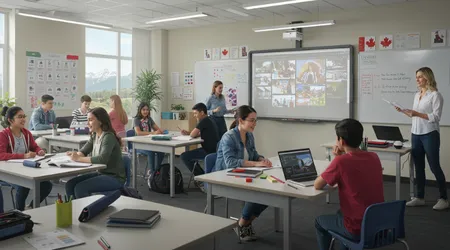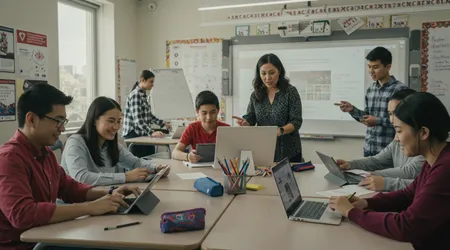Canadian Education Embraces Open Educational Resources (OER) Nationwide

Open Educational Resources are reshaping Canadian education, offering free, adaptable materials that democratize learning.
In 2025, Canada’s education system is at a pivotal moment, embracing these digital tools to foster equity, innovation, and collaboration.
From British Columbia to Nova Scotia, universities, colleges, and K-12 schools are integrating Open Educational Resources to reduce costs and enhance access.
This shift isn’t just about saving money it’s about reimagining how knowledge is shared. Why settle for outdated, expensive textbooks when flexible, inclusive alternatives exist?
This article explores how Open Educational Resources are transforming Canadian classrooms, empowering educators, and building a future where education is truly accessible.
The rise of Open Educational Resources aligns with Canada’s commitment to inclusivity and reconciliation. These resources, often licensed under Creative Commons, allow educators to tailor content to diverse needs, including Indigenous perspectives.
By lowering financial barriers, they ensure no student is left behind. With federal elections looming, education is a unifying force, and Open Educational Resources are central to this vision.
From policy frameworks to grassroots initiatives, Canada is crafting a model that balances innovation with equity, setting a global standard.
The Cost-Cutting Power of OER
Textbooks once drained student budgets, but Open Educational Resources offer relief. Concordia University’s OER program, for instance, saved students over $1 million since 2012.
Free access eliminates financial stress, letting students focus on learning. Imagine a first-year student, Sarah, accessing a biology textbook without a $200 price tag. Her relief is palpable, her potential unleashed.
This affordability extends beyond students. Faculty save time with pre-built, adaptable OER materials. Platforms like BCcampus provide thousands of open textbooks, reducing prep costs.
++ Canada Caps New International Students at 437,000 in 2025: What That Means for Higher Ed
Institutions benefit too, redirecting funds to infrastructure or student support. The ripple effect is profound education becomes a right, not a privilege.
Yet, savings don’t compromise quality. OERs from top institutions like UBC ensure rigorous standards. Peer-reviewed platforms maintain credibility, making costly textbooks obsolete.
Canada’s embrace of OER reflects a commitment to equitable education, leveling the playing field for all.

Fostering Collaboration and Innovation
Collaboration drives modern education, and Open Educational Resources fuel this dynamic. Think of OER as a shared canvas, where educators and students co-create knowledge.
At the University of Winnipeg, professors remix open textbooks, integrating local case studies. This fosters engagement, as students see their communities reflected in learning.
OER platforms like MERLOT enable global knowledge exchange. A teacher in Alberta might adapt a resource from Ontario, enriching their curriculum.
This cross-provincial synergy sparks innovation, ensuring content stays fresh. Students like Malik, studying anthropology, contribute feedback, shaping resources for future learners.
Also read: University of Toronto–Harvard Cross‑Border Initiative Supports Graduate Students
Such collaboration extends to Indigenous education. OERs incorporate traditional knowledge, respecting cultural contexts. By fostering dialogue, they support reconciliation efforts.
Canada’s education system thrives when voices local, global, Indigenous merge through open resources, creating vibrant, inclusive learning communities.
Enhancing Equity and Inclusivity
Equity lies at the heart of OER adoption. Expensive textbooks often exclude low-income students, but Open Educational Resources bridge this gap.
In 2025, 82% of Canadian educators using OER report enhanced student engagement. Free resources ensure everyone, from rural learners to urban scholars, accesses quality materials.
Consider Maria, a single mother studying at Lethbridge Polytechnic. OERs allow her to learn without financial strain, balancing work and education.
Read more: Canada Adds 119 New Eligible Programs to PGWP List as of June 2025
Customizable content also supports diverse needs, like braille adaptations for visually impaired students. This inclusivity strengthens Canada’s social fabric.
OERs also promote cultural relevance. Multilingual resources in Hindi, French, or Cree reflect Canada’s diversity.
By centering marginalized voices, they challenge Western-centric curricula. Education becomes a tool for empowerment, ensuring no one is priced out or left behind.
Technology as a Catalyst for OER

Digital transformation amplifies OER’s impact. Cloud-based platforms like OpenStax deliver seamless access to resources.
Students access materials anytime, anywhere, from laptops or phones. AI tools enhance OER, offering personalized quizzes, as seen in Ottawa’s Catholic School Board.
Blockchain ensures OER credentials are secure, boosting trust in certifications. Imagine a virtual library, endlessly expandable, where knowledge flows freely.
Educators integrate OER into learning management systems, streamlining teaching. This synergy reduces costs and enhances interactivity.
Yet, the digital divide persists. Rural areas face connectivity challenges, limiting OER access. Initiatives like DIKSHA provide offline solutions, ensuring no learner is excluded. Technology, paired with OER, makes education agile, responsive, and future-ready.
Policy and Advocacy: A National Vision
Canada’s provinces lead OER adoption, but a national strategy is emerging. The Canadian Association of Research Libraries (CARL) formed an OER National Strategy group in 2021, advocating federal support. This vision balances provincial autonomy with shared goals, fostering coherence.
British Columbia’s BCcampus, a pioneer since 2012, saved students millions. Other provinces follow, with Quebec’s Concordia University launching O manuscript on January 27, 2022.
A federal framework could amplify these efforts, scaling success nationwide. Why not lead globally with a unified OER model?
Policy also supports Indigenous-led education. OERs integrate traditional knowledge, aligning with truth and reconciliation.
By advocating for federal involvement, Canada can set a global standard, blending innovation with equity. Education becomes a unifying force, not a fragmented one.
Overcoming Challenges in OER Adoption
OER adoption isn’t flawless. Connectivity issues hinder 30% of rural Canadian learners. Offline solutions like USB drives are bridging this gap.
Awareness remains low only 15% of educators actively use OER. Workshops and advocacy are changing this.
Quality concerns linger, but peer-reviewed platforms like OER Commons ensure reliability. Faculty need support to adapt resources efficiently.
Grants, like Concordia’s, fund customization, easing the burden. Sustainability requires ongoing investment, but institutional commitment is growing.
Licensing confusion also poses challenges. Clear Creative Commons guidelines are essential. By addressing these hurdles, Canada ensures OER’s long-term success, making education accessible and adaptable for all learners.
| OER Platform | Institution | Impact | Year Launched |
|---|---|---|---|
| BCcampus | British Columbia | Saved $1.8M+ for students | 2012 |
| OpenStax | Global | Used in 100+ countries | 2012 |
| DIKSHA | India | 200M+ users globally | 2017 |
| Concordia OER | Concordia University | Saved $1M+ for students | 2022 |
OER in Action: Real-World Examples
At Concordia, the open textbook Better Practices in the Classroom transforms teaching. It integrates gender and sexuality studies, empowering diverse learners.
Faculty tailor it to local contexts, enhancing relevance. Students engage deeply, seeing their realities reflected.
In Alberta, Salinda Hess uses Explorations: An Open Invitation to Biological Anthropology for her ANTH 203 course.
Students critique and enrich it, fostering active learning. These examples show OER’s power to engage, adapt, and inspire across disciplines.
Such initiatives ripple beyond classrooms. Students like Lola Leus, who worked on an OER project, gain skills and agency. OERs empower learners to shape their education, creating resources that evolve with each generation.
The Future of OER in Canada
Looking ahead, OER will define Canadian education. Platforms like SWAYAM and DIKSHA, with 200 million users, show scalability.
Canada can emulate this, expanding access nationwide. Integration with AI will personalize learning further, keeping pace with global trends.
Indigenous-led OERs will grow, embedding traditional knowledge into curricula. This aligns with Canada’s reconciliation goals, ensuring education respects all voices. Federal support could amplify these efforts, making Canada a leader in open education.
Sustainability hinges on collaboration. Universities, governments, and communities must unite. By investing in OER, Canada builds an education system that’s inclusive, innovative, and ready for the future.
Conclusion
Canada’s embrace of Open Educational Resources marks a transformative era in education. These tools break down barriers, foster collaboration, and prioritize equity.
From cost savings to cultural relevance, OERs empower students and educators alike. As Canada navigates a digital, AI-rich world, Open Educational Resources offer a path to inclusive, innovative learning.
By scaling provincial successes and fostering a national vision, Canada can lead globally. The future is open let’s seize it, ensuring every learner has access to knowledge that inspires and uplifts.
Frequently Asked Questions
What are Open Educational Resources?
OERs are freely accessible, openly licensed materials like textbooks and videos, adaptable for teaching and learning, promoting equity and cost savings.
How do OERs benefit Canadian students?
They reduce textbook costs, enhance access, and allow customization, ensuring inclusive, relevant education for diverse learners across Canada.
Are OERs reliable for academic use?
Yes, platforms like OER Commons and OpenStax are peer-reviewed, often backed by top institutions, ensuring high-quality, credible content.
How can educators start using OER?
Explore platforms like BCcampus or OpenStax, verify Creative Commons licenses, and join OER communities to adapt resources effectively.
What challenges do OERs face in Canada?
Connectivity issues, low awareness, and licensing confusion persist, but offline solutions and advocacy are addressing these barriers effectively.
